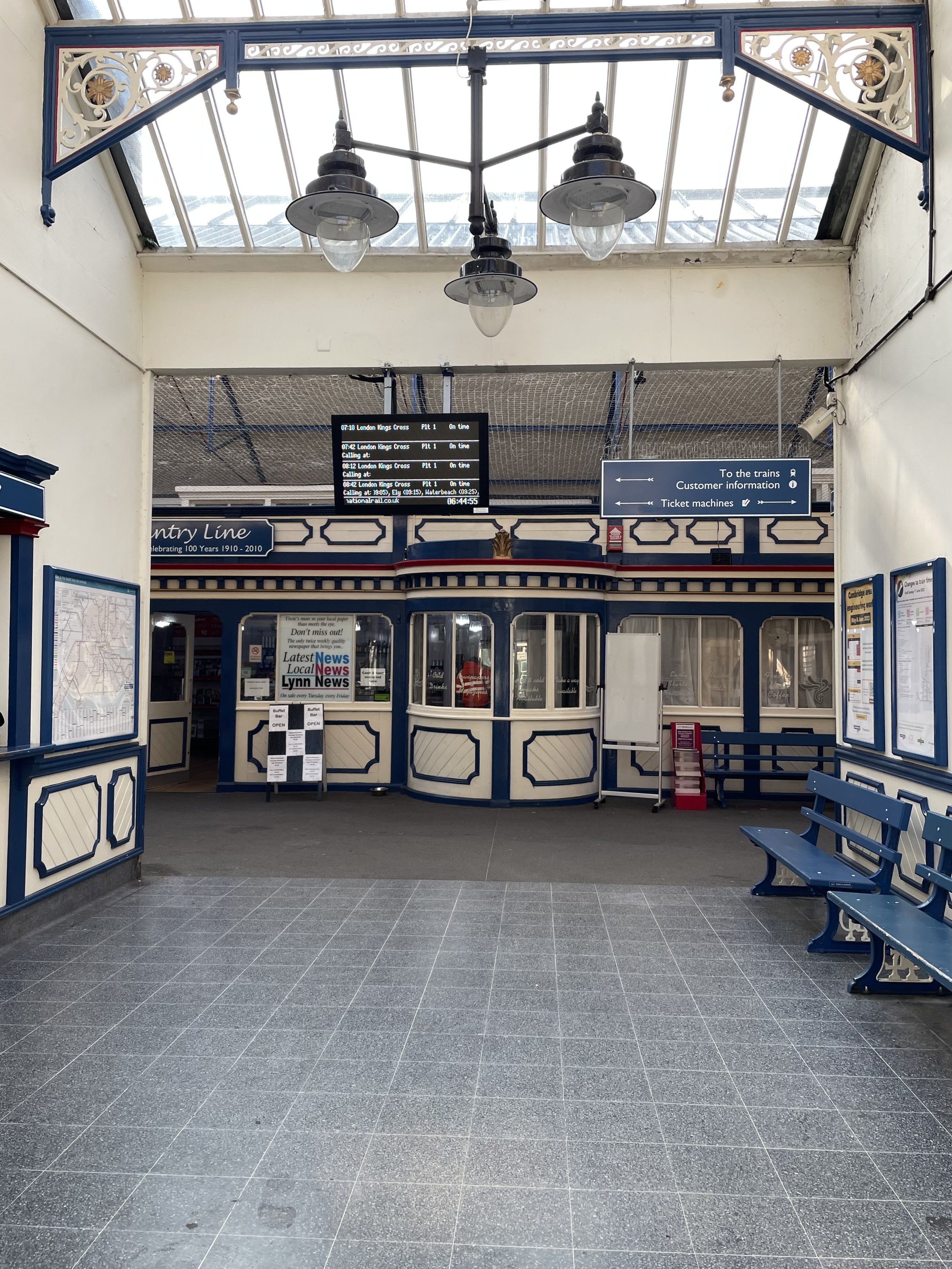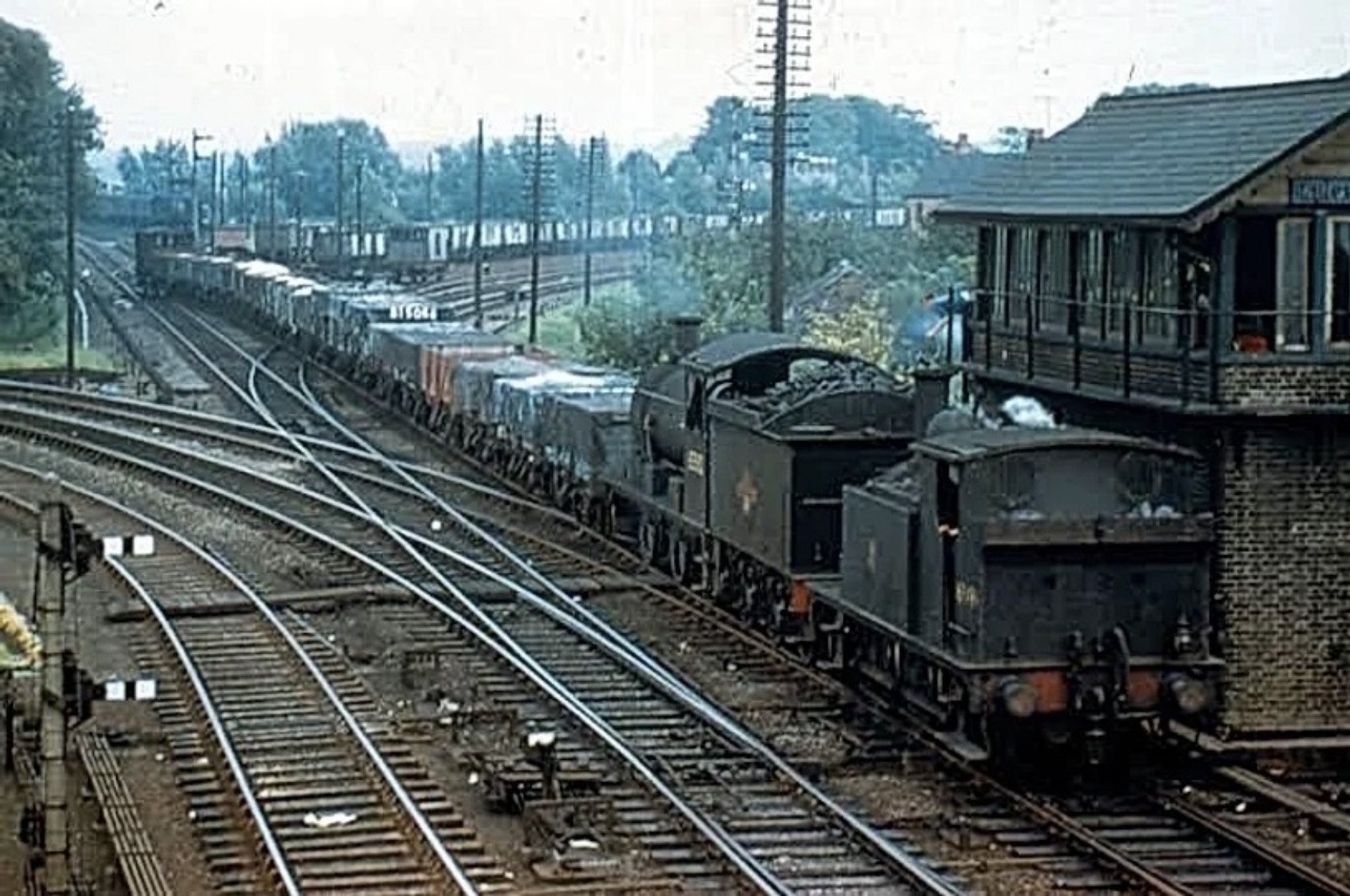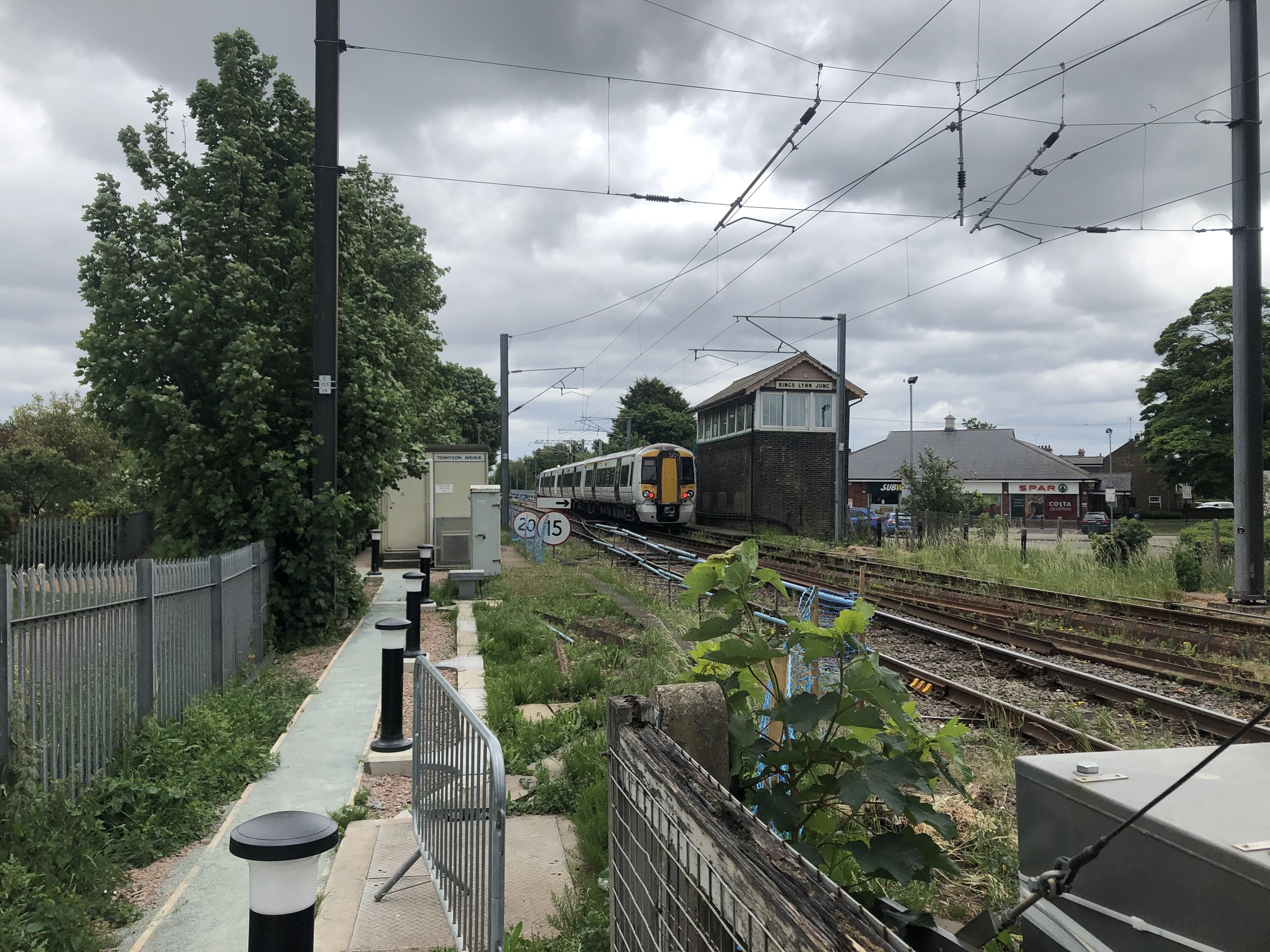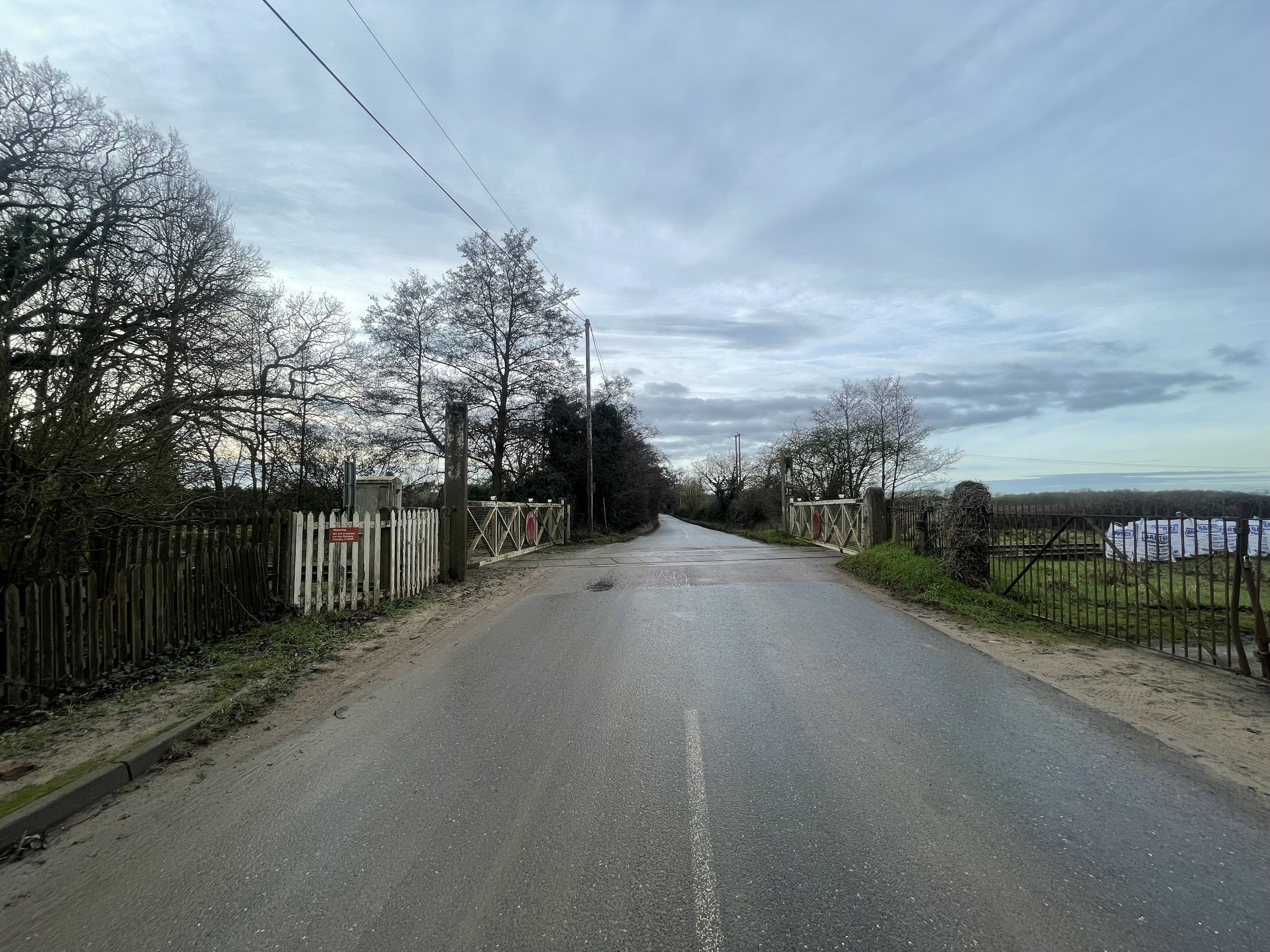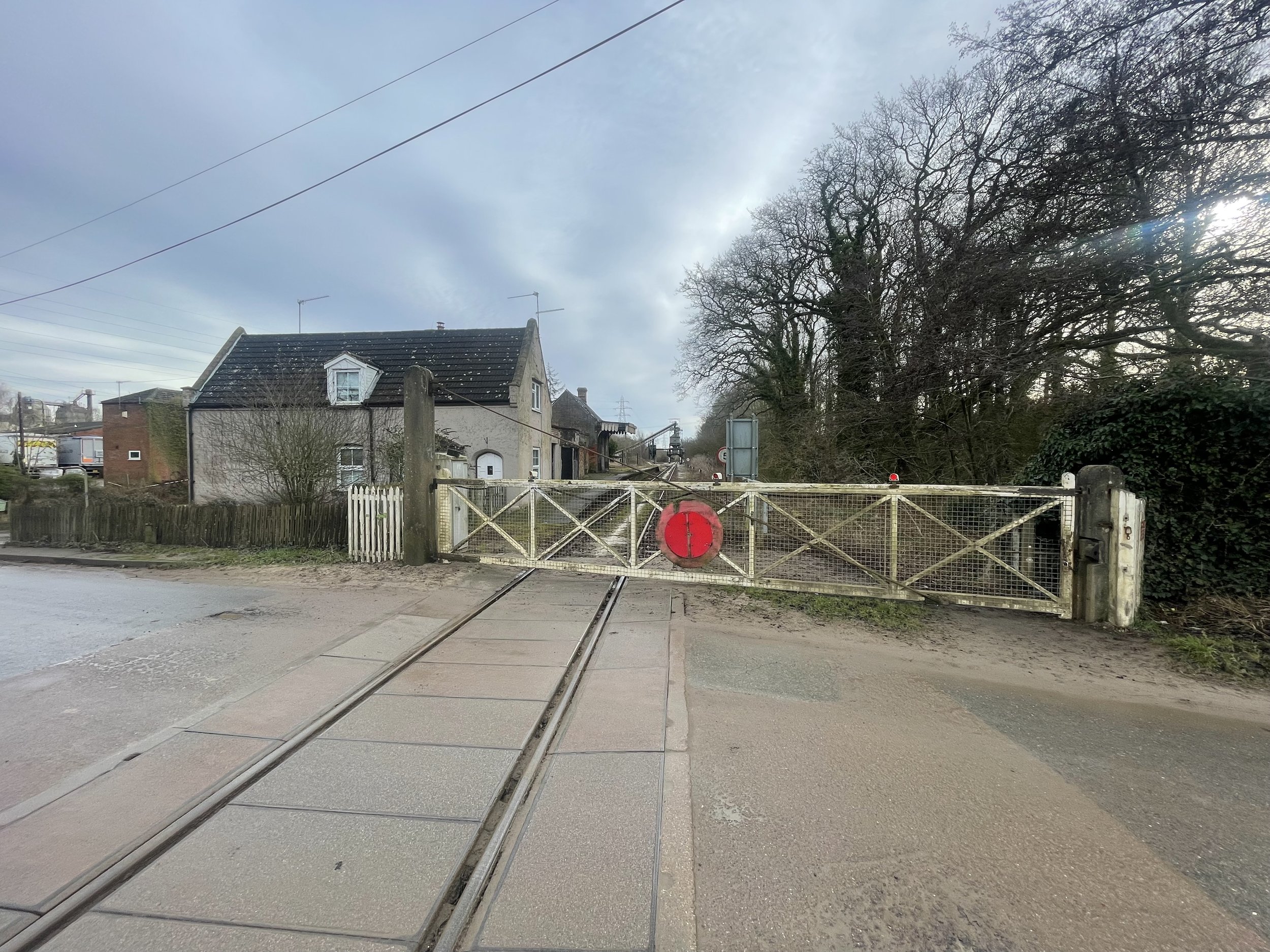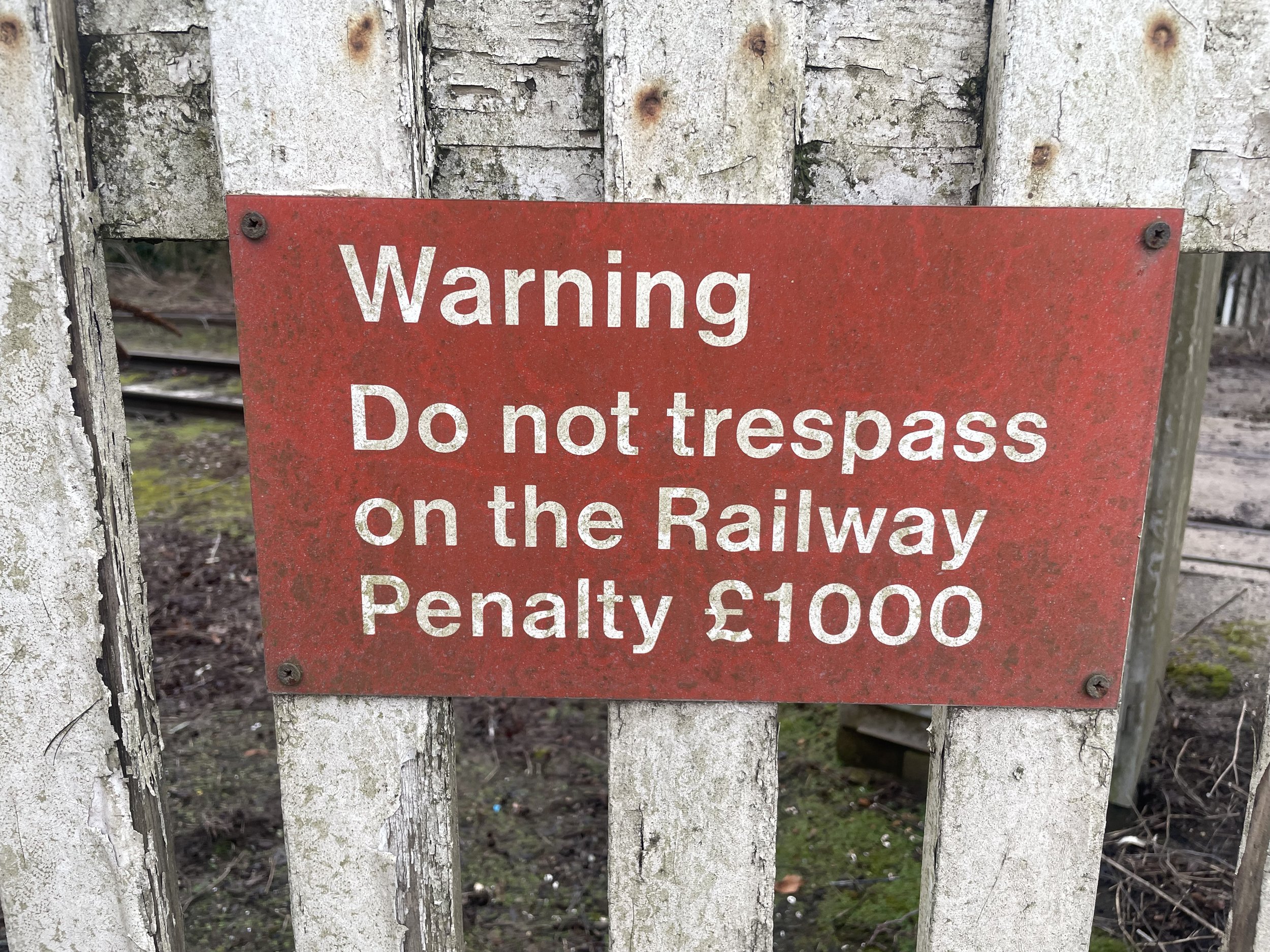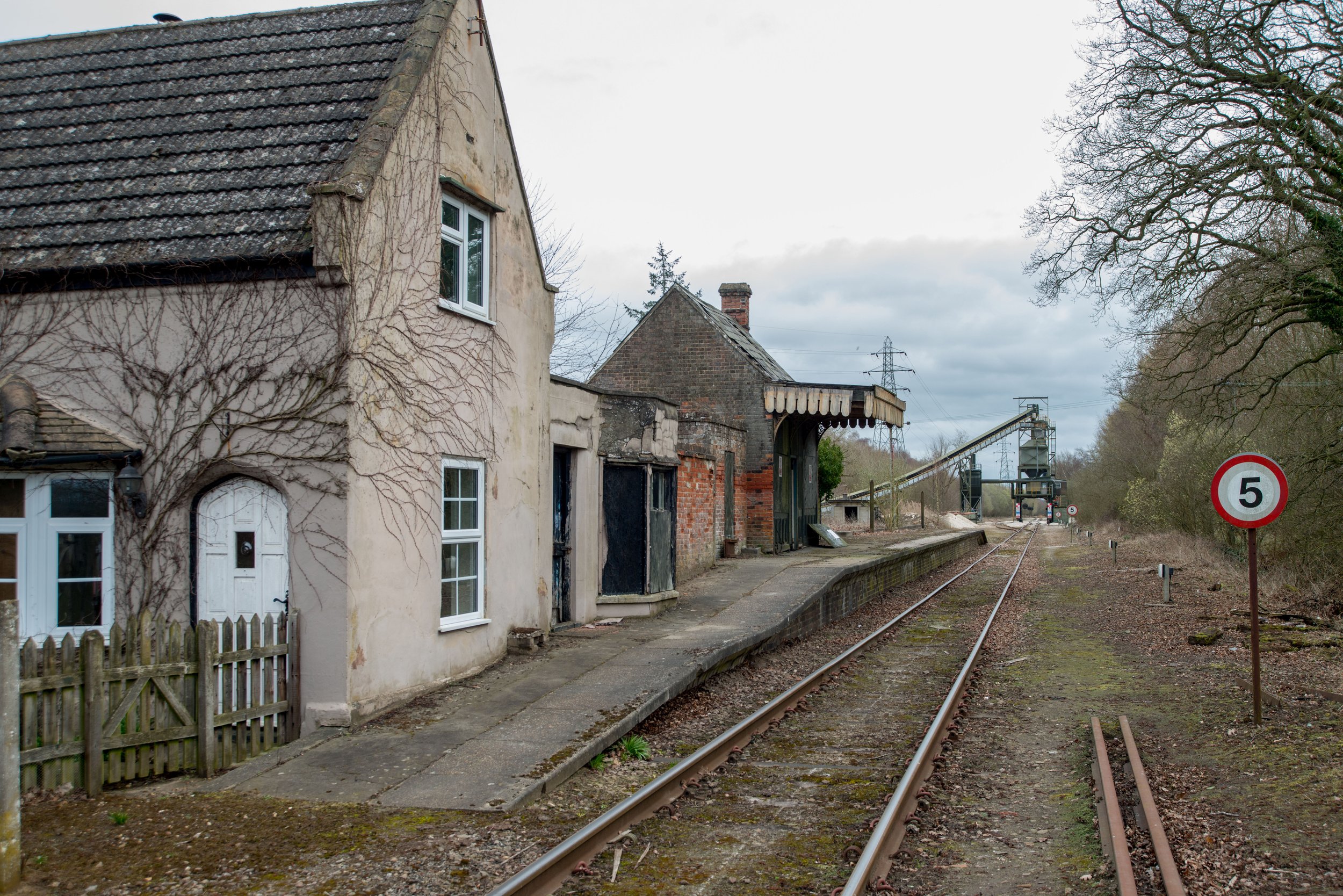1846-1968

To navigate through the route, kindly make use of the navigational icons located below that correspond to each part of the route.
WELCOME TO PART ONE
KING’S LYNN TO EAST WINCH VIA MIDDLETON TOWERS
King’s Lynn Station
Located on the East Coast, this port and market town was called Bishops Lynn in the 15th century.
The origins of Bishops Lynn date back to the 10th century, but the first recorded mention of it was in the 11th century.
King's Lynn Station was in Norfolk, the original station opened in 1846 after the Lynn, Ely railway line opened.
Back in the day, this was just a basic wooden structure.
The Dereham line was created during the years 1846 & 1848.
Another branch, starting from Watlington (previously called Magdalen Road), began operating in 1848 and provided transportation services to Wisbech and March, also originating from King's Lynn. Furthermore, the Hunstanton line originating from King's Lynn was established in 1862, and the South Lynn M&GN station was built in 1865.
Then in 1871, several companies collaborated to create a more durable station, resulting in the present-day terminal we now witness.
The recently built station now has two island platforms, each with four dead-end lines in between and bays on both sides. It has replaced the old wooden structure that previously stood in its place.
Even though it is a Terminus, King's Lynn used to see many trains continuing to Hunstanton from the Lynn-Ely Line and the M&GN at South Lynn via a shuttle line, which is also covered on this website.
The summer months were particularly busy, with restaurant cars and royal services heading towards the Norfolk coast.
At the end of King's Lynn station, there was a vast goods yard that could only be accessed through the King's Lynn junction by the signal box. Furthermore, a junction existed where the railway connected to the Lynn Docks branch.
Between the goods lines and the bay platforms lay King's Lynn's engine sheds. This brick-built structure featured four roads and accommodated a variety of engines, including numerous royal engines. By the 1950s, the sheds were capable of accommodating many locomotives. However, in 1959, the sheds were closed to steam locomotives.
Access to the sheds was only possible through the junction located near the signal box.
During the early days of the station, there was a signal box located at the end of the platforms in King's Lynn, along with a significant semaphore signal system.
As the trains left King's Lynn, they passed by the engine sheds and goods yards before reaching King's Lynn Junction. At the junction, they continue straight ahead, crossing underneath the footbridge. On the left, you can see the Hunstanton Branch, while the Ely-Cambridge line heads off to the right. Now on its own dedicated line, the Dereham line quickly heads towards its next station, Middleton Towers, through open countryside.
At the junction, there was the second signal box, King’s Lynn Junction Box. The King’s Lynn Junction box was said to have housed an 80-lever frame.
When writing this page, King’s Lynn still operates at a working mainline station with services towards Ely, Cambridge and London with hourly services to the capital.
Currently, there is only one signal box remaining. There have been discussions about establishing a central control centre at Cambridge, which would render all signal boxes obsolete. It is still being determined how long the remaining signal box will continue to be operational.
The Goods Yard and engine sheds have undergone significant changes, with most of it being torn down and replaced by a supermarket and retail establishments. However, a portion of it remains in use as a turnaround point for freight services headed to Middleton Towers.
The Hunstanton Line was closed in 1969, just one year after the Dereham Line shut down. Similarly, the Wisbech and Watlington branch was closed around the same time as the Dereham Line.
At present, the segment of the former Dereham railway line leading up to Middleton Towers is utilised as a freight line catering to the needs of the sand quarry.
In 2020, a portion of the old Dereham line near King's Lynn junction was renovated to accommodate stabling points for storing 8-car units.
1846-1848, The Lynn to Dereham railway line opened with King’s Lynn wooden built station.
1862, the Lynn Hunstanton Railway opened.
1865, the M&GN South Lynn Station opened.
1871 The station that is still in use today opened.
1911, the station changed its name from Lynn to King's Lynn.
1959 The M&gnjr line closes.
1968, the Dereham branch closes.
1969 May, the Hunstanton branch closes.
1992, the line to now London King's Cross is electrified between London King's Cross & Cambridge.
King’s Lynn station Layout
Dated 1892-1914
Thanks to the national library of Scotland.
Kings Lynn station aerial
Views past & present
I would like to express my gratitude to Historic England for providing the Embed code that enabled me to use the aerial photos displayed below.
Thanks to Historic England for the aerial photo. Please click on the photo for a link to the source page.
Photographer unknown
Thanks to Historic England for the aerial photo. Please click on the photo for a link to the source page.
Kings Lynn station past & present
King’s Lynn railway station roughly in the late 1960s
King’s Lynn railway station Photographed in 2020
King's Lynn station early morning, taken in between the Christmas and the new year break in 2022
King’s Lynn station Foyer year unknown but in the Days of LNER with destinations to Hunstanton.
Dereham,Norwich,Yarmouth,Lowestoft,
Wisbech,Peterbrough and off to the east coast main line to Doncaster York.
Ely Cambridge and back in the Day Liverpool street (Services still run but now to London King’s Cross)
Sourced from FaceBook Under licence Credit-Photographer and year unknown
King’s Lynn station foyer and cafe in 2023
"There are a few pieces of railway memorabilia on display at King's Lynn."
Credit Lewis Collard via Wikimedia.
King’s Lynn Platforms Past
In this photo, we can observe a steam excursion train arriving at King's Lynn during the 1950s. It is believed that this train was the Hunstanton excursion service. Additionally, the image features the Signal box and one of the semaphore signals.
Ben Brooksbank, CC BY-SA 2.0, via Wikimedia Commons
A Dereham or Hunstanton Bound DMU on Platform 2 at King’s Lynn.
In 1992, an EMU was parked on platform 2, where most Dereham services departed from, shortly after the completion of electrification from Ely and Cambridge.
© Copyright Ben Brooksbank and licensed for reuse under this Creative Commons Licence.
King’s Lynn Platforms Present
In the past, the Dereham trains would leave from Platform 2 located at King's Lynn station.
Additionally, trains heading to Hunstanton and Wisbech and March also departed from this platform. Currently, Platform 2 is utilized for stable trains and peak-time departures to London King's Cross. Platform 1 is the most frequently used platform at King's Lynn for London-bound services.
Platform One King’s Lynn
King’s Lynn Platforms one and two with class 387’s stabled up
Creative Commons CC0 1.0 Universal Public Domain Dedication Lewis Collard
Kings’s Lynn Junction
Kings Lynn Junction Historic Maps
The Dereham line can be seen heading straight off to Middleton Towers.
Once departing from King's Lynn station, the trains quickly approach Kings Lynn Junction, where the Docks branch intersects just before the Tennyson Avenue level crossing. At this junction, the Hunstanton line veers off to the left, followed by the Lynn, Ely, and Cambridge line to the right. The Dereham bound line continues on a south-east trajectory towards Middleton Towers.
During King's Lynn's prosperous times, King's Lynn Junction featured the Dereham Swaffham Branch, which extended straight ahead. The Hunstanton branch was to the left, while the London Cambridge line was to the right.
A freight train, identified as 37023, is currently on the return journey after loading silica sand at Middleton Towers. Its destination is the King's Lynn turn-around point located on the old and disused Docks railway line.
Thanks to Martin Addison via Geograph
Attribution-ShareAlike 2.0 Generic(CC BY-SA 2.0)
A freight train with double engines has just arrived at King's Lynn junction from Middleton Towers via the Dereham branch.
The King's Lynn Junction looks quite different in 2020 compared to the past. The Hunstanton branch junction is no longer present, and a considerable number of sidings from the Dereham branch have also disappeared.
The Dereham line, which appears to continue straight ahead, serves as a resting place for 8-car units that have been in operation between King's Lynn and Cambridge since 2020. Additionally, it is still utilized as a freight line up to Middleton Towers.
Off to Middleton Towers
The train continued on its route after passing Kings Lynn Junction, making its way to the next stop at Middleton Towers. A photograph of the area was captured in 2020 from the footbridge located at the Hardwick industrial estate.
The image shows the train track running alongside the estate, primarily used for freight transportation.
The Dereham line now passes under the A149 Bypass in-between the hospital and the Hardwick estate.
After crossing the A149 bridge, the railway line passed under the M&gn. The Dereham railway was located beneath the M&gn line, which was elevated over it through a bridge.
The M&gn line provided connections from King's Lynn's South Lynn station to several destinations in Norfolk and Lincolnshire, such as Fakenham, Melton Constable, Norwich, Peterborough, Sutton Bridge, and many others.
Thanks to the national library of Scotland for the maps used below.
Here we see two historical maps. The first shows the now-constructed A149 passing over the Lynn Dereham Railway, while the second shows the M&GN passing over the same railway.
Google maps coverage below of the position of the M&Gn & Lynn Dereham Crossing
To view the terrain, kindly click on the icon located in the right-hand corner.
I would like to express my gratitude to Andy F for sharing these amazing pictures with us through Geograph.
The initial image shows the Lynn Dereham line passing beneath the disassembled bridge that previously held the South Lynn to Gayton Road M&GN Train to Fakenham.
Lastly, there are two images of a farm crossing, which I assume were taken right after the bridge.
https://www.geograph.org.uk/profile/32299
Attribution-ShareAlike 2.0 Generic(CC BY-SA 2.0)
The following images were provided by Alex Brammer from Middleton Towers Restoration Group, who are working towards restoring Middleton Towers Station.
The following images were provided by Steve Heywood from the Midland & Great Northern Joint Railway M&GN Facebook Group
In the first picture, we can see the M&GN Track bed with the Dereham line passing underneath it.
Off to Middleton Towers
After passing the M&gn crossing, we will arrive at Middleton Towers Station and the freight yard, which is currently utilized for freight transportation.
Just before the crossing gates, we can spot some hoppers on the King's Lynn side.
Middleton Towers Level crossing
The crossing gates at Middleton Towers were said to be the original gates from when the railway was in operation until 2024 when sadly one of the gates was damaged.
The two pictures below were taken while volunteering for the Middleton Towers restoration group with Network Rail on site. I was wearing full PPE and had permission to be in this area.
In Autumn 2023, a freight service departs from Middleton Towers.
One of the level crossing posts at Middleton Towers has a sign that says "3 Miles 11 Chains".
This distance is either to the Kings Lynn station or King's Lynn Junction.
Middleton Towers Gate Furniture.
Replacement gates at Middleton Towers station
On May 18, 2024, the Downside gate was sadly demolished due to an unfortunate accident. Network Rail replaced the old wooden gate with a temporary metal gate and will replace the Downside gate with a new bespoke 28-foot gate complete with ironwork. The process of ordering and completion will take around 16 weeks. Please keep an eye on social media for updates. Thanks to Alan White, Infrastructure Maintenance Engineer from Network Rail, for all the information and for replacing the gate to the same specifications as before, maintaining the old appearance.
I want to express my gratitude to everyone involved in the process of replacing this old gate. Thank you!
Credit-Alan White Infrastructure Maintenance Engineer from Network Rail
Temporary metal gates installed on Sunday, May 19, 2024.
A remaining support from the recently damaged level crossing gates at Middleton appears undamaged.
New crossing gates.
On November 24, 2024, Network Rail wonderfully installed the new crossing gates at Middleton Towers, coinciding with the 100th anniversary of the station's renaming from Just Middleton to Middleton Towers.
The Network Rail team ©Lynnnews
New Gate Furniture.
Services at Middleton Towers
A class 66 at Middleton Towers in November 2020
On September 10, 2023, a charter passenger train, pulled by Class 66 trains, travelled the Dereham branch to the Level Crossing for the first time in many years.
Class 69 seen above at Middleton Towers in November 2024 thanks to ©Alex-Brammer of the Middleton Towers Restoration Group for the Photo Supplied
Fen Tiger" tour on 12th July 1986
Middleton Towers Station
We have now arrived at Middleton Towers station, having travelled a distance of three miles and 15 chains from King's Lynn. Originally named Middleton when it first opened on October 27, the station was later renamed Middleton Towers on November 1. During the early days of railways, it was one of six designated stop stations where passengers had to specifically request for the train to stop.
The station had one platform with freight sidings beside it, and a station building situated at right angles to the track. A canopy was also present, and the control of Middleton Towers was managed by a two-story signal box. Throughout its operation, the station was managed by William Davis, William Nunn, Robert Simpson, Albert Peacock, and George Taylor.
In the past, Middleton station was located over a mile away from the main village, and local villagers would take a pleasant walk to reach it. Nowadays, Middleton Towers station is the only section of the forgotten railway that remains operational, transporting silica sand from a nearby quarry. Middleton, like all other stations on this line, closed down in 1968 for passenger use.
Despite currently being unused and in disrepair, there is hope for the restoration of Middleton Towers. I am proud to be part of the Middleton Towers Restoration Group, which was established in June 2021 under the leadership of Alex Brammer.
Alex and his team of volunteers, including myself as a photographer, are committed to transforming this historical site into a museum, and we have made significant progress towards achieving our goal.
Middleton Towers station maps
I would like to express my gratitude to the National Library of Scotland.
Google maps coverage below of the position of Middleton Towers.
Historic map showing Middleton Towers station with the line after the sand loading bay shown as dismantled.
Middleton Towers station present state
Early days of the restoration by Middleton Towers Restoration Group, taken in late July 2024, a few weeks into the restoration.
I found this drain near the station, close to the level crossing. It shows a locally made drainage system by the Savages of King’s Lynn, who are renowned for their fairground engineering.
I took this photo from the Platform at Middleton Towers station while volunteering for the Middleton Towers Restoration group.
We were granted permission to access the platform and wore full PPE during our visit.
Kindly refrain from entering this site without obtaining prior permission.
Off to East Winch
Departing Middleton Towers, the railway led towards the next station on the route, East Winch. This section of the railway, spanning 5 miles and 15 chains from King's Lynn, was a brief journey on a single-line track located approximately 2 miles from Middleton Towers.
The brief journey was through scenic countryside, passing by farms and rural landscapes without encountering any intersections on the way.
Please join us on this journey and click the link below for the second part along the Lynn Dereham Line.













